
Join the ECS LinkedIn group.
This was a question in our LinkedIn group from
I need to know that can we use the Autolab PGSTAT30 for long term (about 20 hours) cathodic polarization of samples? Can any one help me?

Join the ECS LinkedIn group.
This was a question in our LinkedIn group from
I need to know that can we use the Autolab PGSTAT30 for long term (about 20 hours) cathodic polarization of samples? Can any one help me?
If you’re a cycler, you know this problem all too well: you’re stopped at a traffic light, the only vehicle at a controlled intersection, and are waiting for the seemingly never-ending red light to change. Now, thanks to Nat Collins’ new development, you may not have to encounter this problem.
Collins has created a device called the Veloloop, which uses a patented circuit technology to trigger sensors in asphalt. In essence, the device is designed to make traffic light sensors think that your bike is a car.
This from Gizmag:
Embedded “inductive loop” traffic sensors work by creating an electromagnetic field in the surface layer of the road. When a sufficiently-large metal object – such as a car – stops above the sensor, it creates eddy currents within that field. This is detected by the system’s traffic signal controller, which causes the light to change.
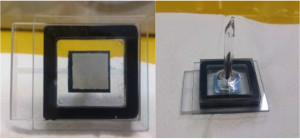
Scientists have developed a new type of energy-efficient flat light source with a power consumption about a hundred times lower than that of an LED.
Credit: N. Shimoi/Tohoku University
Scientists all around the globe are constantly looking for a way to create the even-better-bulb of tomorrow. In order to do this, researchers are looking toward carbon electronics.
This from the American Institute of Physics:
Electronics based on carbon, especially carbon nanotubes (CNTs), are emerging as successors to silicon for making semiconductor materials, and they may enable a new generation of brighter, low-power, low-cost lighting devices that could challenge the dominance of light-emitting diodes (LEDs) in the future and help meet society’s ever-escalating demand for greener bulbs.
With this in mind, scientists from Tohoku University have developed a new type of energy-efficient flat light source with a very low power consumption that comes in around 0.1 Watt for every hour of operation. This is about one hundred times lower than that of an LED.
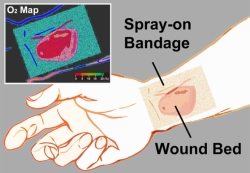
The transparent bandage displays an oxygen-sensitive colormap.
Credit: Li/Wellman Center for Photomedicine
A paint-on, see-through bandage – fully equipped with oxygenation sensors – has been developed with the purpose of better aiding wounded soldiers and improving the success of surgeries to restore limbs and physical functions.
Not only does it protect wounds and burns as any bandage should, but it also enables direct measurement and mapping of tissue oxygen.
The “smart” bandage was developed by an international, multidisciplinary team of researchers led by Assistant Professor Conor L. Evans at the Wellman Center for Photomedicine of Massachusetts Generall Hospital (MGH) and Harvard Medical School (HMS). The group’s findings have been recently published in The Optical Society’s (OSA) open-access journal Biomedical Optics Express.
This from The Optical Society:
Now, the “smart” bandage developed by the team provides direct, noninvasive measurement of tissue oxygenation by combining three simple, compact and inexpensive components: a bright sensor molecule with a long phosphorescence lifetime and appropriate dynamic range; a bandage material compatible with the sensor molecule that conforms to the skin’s surface to form an airtight seal; and an imaging device capable of capturing the oxygen-dependent signals from the bandage with high signal-to-noise ratio.
“Any sufficiently advanced technology is indistinguishable from magic.”
-Arthur C. Clarke
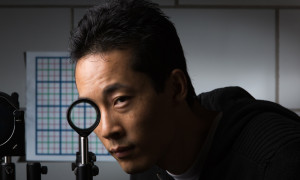
Doctoral student Joseph Choi is pictured with a a multidirectional `perfect paraxial’ cloak using 4 lenses.
Credit: University of Rochester Newscenter
Scientists at the University of Rochester have developed a real-world invisibility cloak. This Harry Potter-esque cloak has the ability to hide objects from view, and is surprisingly inexpensive due to the readily available materials in its novel configuration.
“There’ve been many high tech approaches to cloaking and the basic idea behind these is to take light and have it pass around something as if it isn’t there, often using high-tech or exotic materials,” said John Howell, a professor of physics at the University of Rochester.
The Rochester Cloak is different from its predecessors, because unlike invisibility cloaks of the past, this cloak maintains an object’s invisibility even when the viewer changes his or her angle and creates a different viewpoint.
“This is the first device that we know of that can do three-dimensional, continuously multidirectional cloaking, which works for transmitting rays in the visible spectrum,” said Joseph Choi, a PhD student at Rochester’s Institute of Optics who is working with physics professor John Howell at the university.
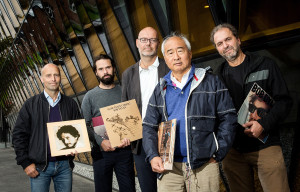
The band of researches at Karolinska Institutet have been partaking in a 17-year contest to see who can quote Bob Dylan the most in scientific articles before going into retirement.
Credit: Karolinska Institutet
A group of Swedish-based academics have been in a heated competition for the past 17 years – a competition over who can sneak the most Bob Dylan lyrics into articles, that is.
A group of five scientist from the Karolinska Institutet have revealed their long-running race to quote Dylan as many times as possible before retirement. The victor is to be awarded a free lunch at a local restaurant.
The competition began in 1997 after John Lundberg and Eddie Weitzberg published “Nitric Oxide and Inflammation: The Answer Is Blowing In the Wind” in Nature.
“We both really like Bob Dylan so when we set about writing an article concerning the measurement of nitric oxide gas in both the respiratory tracts and intestine, with the purpose of detecting inflammation, the title came up and it fitted there perfect,” says Weitzberg.
A few years later, the two saw an articles titled, “Blood on the Tracks: A Simple Twist of Fate,” by Jonas Frisen and Konstantinos Meletis. With this double Dylan reference, Lundberg and Weitzberg could not resist the competition. Shortly after, the two introduced “The times they are a-changin’” into an article and the battle was on.
This from The Guardian:
Word spread quickly through Stockholm’s Karolinska Institute, where all four men work, and before long there was a fifth competitor: Kenneth Chien, a professor of cardiovascular research, who is also keen to win a free lunch. By the time he met the others, he already had one Dylan paper to his name – Tangled Up in Blue: Molecular Cardiology in the Postmolecular Era, published in 1998. With five competing rivals, the pace of Dylan references accelerated. Lundberg and Weitzberg’s The Biological Role of Nitrate and Nitrite: The Times They Are a-Changin’, in 2009; Eph Receptors Tangled Up in Two in 2010; Dietary Nitrate – A Slow Train Coming, in 2011.
Weitzberg explained in an interview with The Local that they didn’t quote Dylan with strict scientific papers, only articles wrote about research by others, book introductions, and editorials.
Take a listen to the playlist we’ve compiled of some of the Dylan tracks that inspired these scientists.
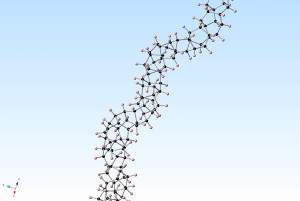
The core of the nanothreads is a long, thin strand of carbon atoms arranged just like the fundamental unit of a diamond’s structure.
Credit: John Badding Lab, Penn State University
A team of scientists have recently discovered how to produce ultra-thin “diamond nanothreads.” These nanothreads, which construct a structure more than 20,000 times smaller than average human hair, are expected to yield extraordinary properties. The new nanothreads will be stronger and stiffer than current nanotubes, and they will also be light in weight.
This means creating the potential for more fuel efficient vehicles, and even fictional-sounding endeavors – such as a “space elevator.”
This from Carnegie Science:
The team—led by John Badding, a chemistry professor at Penn State University and his student Thomas Fitzgibbons—used a specialized large volume high pressure device to compress benzene up to 200,000 atmospheres, at these enormous pressures, benzene spontaneously polymerizes into a long, thin strands of carbon atoms arranged just like the fundamental unit of diamond’s structure—hexagonal rings of carbon atoms bonded together, but in chains rather than the full three-dimensional diamond lattice.
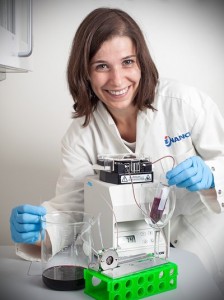
PhD student Joana Guerreiro has taken part in developing a sensor, which has been dubbed the ‘mini-mouth’.
Credit: Lars Kruse, Aarhus University
The ‘mini-mouth’ – that’s what scientists have dubbed the new nanosensor that can mimic the sensation that wine creates in a person’s mouth, which then determines how a specific alcohol tastes.
This technology was created by PhD student Joana Guerreiro from Aarhus University in Denmark, and sets out to detect the level of astringency associated with a particular wine. A wine’s astringency is characterized by the dry sensation drinkers get in their mouth when they drink wine.
This from Aarhus University:
Quite specifically, the sensor is a small plate coated with nanoscale gold particles. On this plate, the researchers simulate what happens in your mouth by first adding some of the proteins contained in your saliva. After this they add the wine. The gold particles on the plate act as nano-optics and make it possible to focus a beam of light below the diffraction limit so as to precisely measure something that is very small – right down to 20 nanometres. This makes it possible to study and follow the proteins, and to see what effect the wine has. It is thereby possible to see the extent to which the small molecules have to bind together for the clumping effect on the protein to be set off.
While the technique itself is not new, the ingenuity lies in using it to create a sensor that can measure an effect rather than just the number of molecules.
This technology seems as though it would threaten the livelihood of sommeliers, but researchers say that is not what the sensor is intended for. Instead, the team at Aarhus University hopes that this will produce a tool that is useful in wine production.
Want to see what else sensors can do? Head over to our Digital Library to see the newest cutting-edge sensor research.
Watch the video and hear at least 23 reasons for coming to the meeting! (Yes, I counted.)
Register now for the 2014 ECS and SMEQ (Sociedad Mexicana de Electroquímica) Joint International Meeting to be held October 5-9, 2014.
This major international conference offers a unique blend of electrochemical and solid-state science and technology; and serves as a major forum for the discussion of interdisciplinary research from around the world through a variety of formats, such as oral presentations (51 symposia and 2,299 papers being presented), poster sessions, exhibits, and tutorial sessions.
ECS is partnering with the Bill & Melinda Gates Foundation to host a multi-day workshop at the 2014 International Electrochemical Energy Summit (E2S) which takes place during the meeting. The workshop will culminate in the distribution of over $200,000 in seed funding from ECS, addressing critical technology gaps in water, sanitation, and hygiene challenges being faced around the world.
Find out more and register online now.
It’s at the beautiful, all-inclusive Moon Palace Resort Hotel, located on the best beach in Cancun and just minutes from the Cancun Airport.
Daily room rates include all of the following:
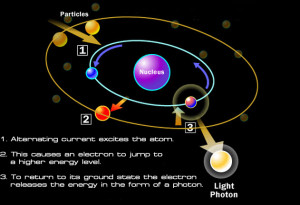
Because it does not require heat to produce light, EL is safe, efficient, and long lasting.
Credit: Darkside Scientific
Imagine being able to paint light on an object. With Darkside Scientific’s patented technology known as LumiLor, the company is now able to turn light into paint.
Recently, the company released a video of a car treated with LumiLor, which showcases the patented technology in all its luminescent glory.
The process is made possible through electroluminescent (EL) coating technologies, which is a characteristic of material that enables it to emit light in response to an electrical field.
The from Darkside Scientific:
At the sub-atomic level, the process behind electroluminescence is radiative recombination, also known as spontaneous emission. In radiative recombination, phosphorescent substances emit photons (light particles) in response to alternating electrical current.
For more information on electroluminescent technologies, check out the wealth of information on the topic in ECS’s Digital Library.